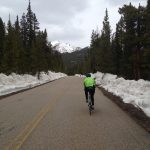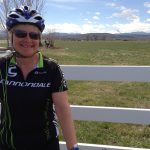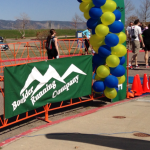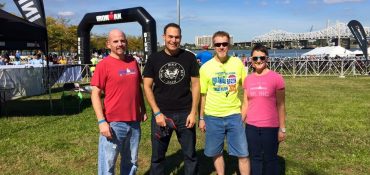
Claudia Blackburn
March, 2013I can breathe again! Imagine that your ability to swim one length of a 25-yard pool at 80% effort would leave you so hypoxic that you needed at least 15 seconds to catch your breath and to think clearly. Envision starting a recovery run feeling as if you went anaerobic within 20 seconds; your hyperventilation tells you that you are working hard but your heart rate doesn’t reflect the perceived effort. Now visualize that you are surrounded by peaks over 14,000 feet, elk herds, and breathtaking vistas, where one moment you are sporting a short-sleeve jersey while riding in mountain-backdrop farmlands, and in the next instant, you are caught in a brief snow squall descending a mountain road leading out of Rocky Mountain National Park. See in your mind’s eye that you are not alone; you are with others whom you admire for their athletic accomplishments and prowess, who have the patience to train the mid-to-back as well the fast and furious, and who understand that accomplishments in the “50 to dead” group may come in smaller increments and at harder effort.
Now you have the picture. I attended a triathlon training camp, Active at Altitude, in Estes Park, with a few side trips thrown in along the way: biking, running (crawling), and fly fishing in Leadville with my coach; a race, cycling, and triathlon shopping experience in Boulder that left me pondering why I can’t have motorcycle escorts and domestiques on my training rides; and an unexpected visit to a vacant emergency room after testing the emergency management and preparedness skills of Estes Park when my running partner slipped on black ice and incurred a complete fracture of his femur. Yikes!
The training camp was a gracious gift from my family. However, this gift challenged my psyche for many months prior to attending. As with any group setting, I feared and fretted that I would hold other people back in training because of my pace, and I was equally terrified of the effects of altitude (years ago, I had a horrific episode of altitude sickness in Colorado at Copper Mountain Ski Resort). I honestly had more trepidation about the training camp than I do about completing the final training regimen leading up to this year’s Lake Placid Ironman or even participating in the race itself.
With adequate time to acclimate, plenty of hydration, and wonderful coaches, my fears and ruminations slipped away. In addition to benefits from the workouts, here are a few reminders and pointers that I took away from the camp…
Mental: Don’t compare yourself to other people; stay focused and set goals that are meaningful to you and your current performance level. When setting goals for a race, set several goals – most people don’t win the race, so goals should be set not only on time within each leg, but other performance aspects as well, such as keeping your bike line as straight as possible, using bilateral breathing on occasion to survey your environment, focus on taking the best line in running to decrease your distance and time, nailing your nutrition every 15-20 minutes, etc.
Cycling: Keep your upper body quiet as you pedal; know gearing and what gear is the same on the large versus small chain ring; don’t double shift; keep the same level of output as you approach the top of the climb (most people ease up); set up regular transition sessions (bricks) – for example, do 4-6 repeats on trainer and treadmill (or trainer and track), 20 minutes on trainer, 10 minutes on treadmill , and then repeat at 85% effort.
Swimming: Do some swim drills using intervals; practice stroke on dry land using an exercise band (cord); remember that your stroke should accelerate as it moves with the water; to double-check hand placement, use the cheap hand paddles and only attach paddles to fingers rather than both fingers and wrist (if the paddle does not remain in place while you swim, your hand placement is incorrect); kicking sets are important in every workout, even as a triathlete; keep your feet angled in so that your toes are almost touching each other when you kick. Take the opportunity to have your stroke analyzed by video (sideways, head on, underwater) – in the training camp, we had our swim stroke evaluated through video a few times during the week. I was actually shocked about what I obtained from this experience. I honestly didn’t expect to learn much more than I thought I already knew.
Running: In addition to your training plan, run as many days as possible for 20-30 minutes to wake up your system in the morning; remember to do dynamic warm-ups before races so that you’re heart ready, including for swim starts – this means getting your heart rate up before the race instead of “saving” yourself for the race; keep focused on turn over. In addition, you can use water running as a substitute to running, if injured or for cross training, provided you use the correct form and pace. For technique and intervals that match running effort, watch this video.
Nutrition and Sleep: Remember that there is a window of opportunity after exercising that is ideal for fueling your body; practice training, at times, with an empty tank; if you are not getting enough sleep, it would be more appropriate to take an active recovery day versus slogging through a hard workout; practice adequate nutrition and sleep – these aspects of fitness are as important as practicing transitions, core and strength training, and endurance sessions.
As a parting note (the psychologist part of me says), remember that beyond the time invested in the training, it is what you say to yourself before and during a race that will greatly determine the outcome.
Best of luck in upcoming races! Claudia







